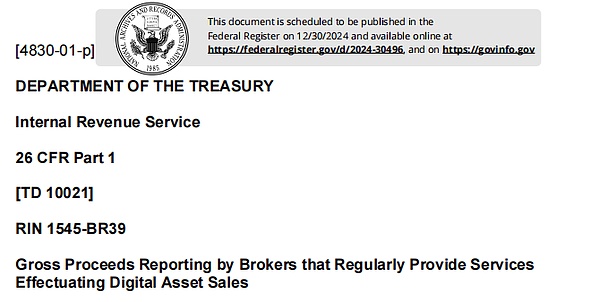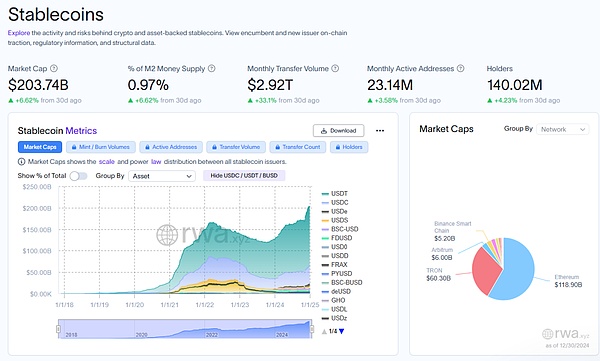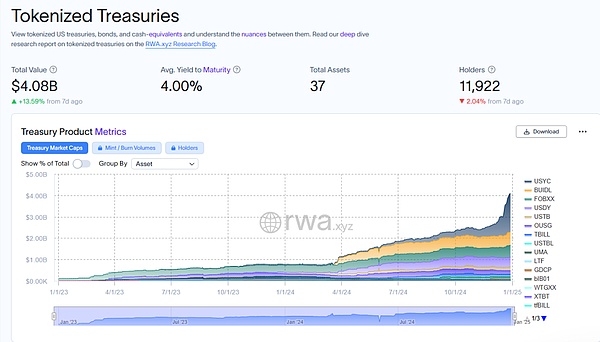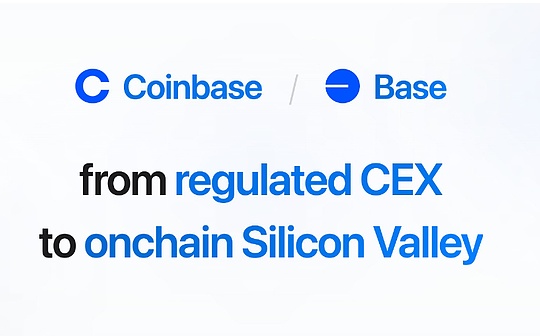
Law document: https://public-nSpection.Federalregister.gov/2024-30496.pdf
>
The U.S. Treasury and the IRS recently released an important new regulations (Rin 1545-BR39), which expands the scope of applicable to existing tax laws.Incorporate DEFI’s front -end service providers into the definition of “brokers”.These service providers, including any platform that directly interacts with users (such as UNISWAP’s front -end interface), is required to collect user transaction data from 2026, and submit information to the U.S. Taxation Agency (IRS) through 2027 Form 1099 in 2027The content includes the total income of the user, the details of the transaction, and the taxpayer identity information.
We all know that Trump’s political stage never lacks drama, and his attitude towards cryptocurrencies is even more so.From the early Bitcoin criticism, it is called “air -based scam”.Worldd
Although the new rules have taken effect for one or two years, and the definition of “brokers” is also controversial. After all, the old -fashioned regulatory policy cannot be set on the encryption project, so it may be overturned.However, Aiying Ai Ying thought about discussing the historical inevitability of the new rules from several dimensions today, and how industry practitioners should conduct strategic choices.
The first part: the logical evolution from traditional colonial to new finance colonies
1.1 Traditional colonial resource logic
The core of the traditional colonial era is to plunder resource plunder through military forces and territorial possession.The United Kingdom controls India’s cotton and tea through East India, and Spain plunder gold from Latin America. These are typical cases of wealth transfer by directly occupying resources.
1.2 Modern model of financial colonial
Modern colonials take economic rules as the core, and achieve wealth transfer through capital flow and tax control.The United States ‘Foreign Account Tax Compliance Act (FATCA) is an important manifestation of this logic. It requires global financial institutions to disclose US citizens’ asset information and force other countries to participate in the US tax governance.The new DEFI taxation rules are the continuation of this model in the field of digital assets. The core is to use technical means and rules to force global capital transparency to obtain more tax revenue for the United States, while strengthening its control over the global economy.
Part 2: New colonial tools in the United States
2.1 Tax Rules: From FATCA to DEFI new rules
The tax rules are the basis of the new colonial model in the United States.FATCA forced global financial institutions to disclose the asset information of US citizens and create a precedent for tax weapons.The new Defi taxation rules continue this logic. By requiring the DEFI platform to collect and report user transaction data, it has expanded the scope of the United States’ control over the digital economy.With the implementation of this rule, the United States will obtain more accurate capital flow data worldwide, thereby further enhancing control over the global economy.
2.2 The combination of technology and the US dollar: the dominant position of stablecoin
Among the 200 billion US dollars, the US dollar stabilization coins accounted for more than 95%. The anchor assets behind it were mainly US Treasury bonds and US dollar reserves.The US dollar stabilizer represented by USDT and USDC, through its application in the global payment system, not only consolidates the global status of the US dollar, but also locks more international capital in the US financial system.This is a new form of the US dollar hegemony in the digital economy era.
>
2.3 The attractiveness of financial products: Bitcoin ETF and trust products
Bitcoin ETFs and trust products launched by Wall Street giants such as Bellaide have attracted a large number of international capital into the US market through legalization and institutionalization.These financial products not only provide greater room for implementation for US tax rules, but also further incorporate global investors into the US economy and ecology.The current market size is $ 100 billion.
>
2.4 Active Assets token (RWA)
Active assets are an important trend in the field of DEFI.According to Aiying Aiying, the scale of US Treasury currency has reached 4 billion US dollars.This model has improved the liquidity of traditional assets through blockchain technology, and has also created new dominance for the United States in the global capital market.By controlling the RWA ecology, the United States can further promote the global circulation of government bonds.
>
Part III: Economic and Financial — Degene pressure and tax fairness
2.1 American deficit crisis and tax loopholes
The American federal deficit is never as worrying as it is now.In fiscal 2023, the deficit was close to $ 1.7 trillion, and the fiscal stimulus and infrastructure investment after the epidemic exacerbated this burden.At the same time, the global market value of the cryptocurrency market exceeded $ 3 trillion, but most of them were separated from the tax system.This is obviously irreversible for a modern country that depends on tax support.
Taxation is the cornerstone of state power.Historically, the United States always seek expansion tax base under the pressure of deficit.The reform of hedging funds in the 1980s was a model of filling the financial gap by expanding the coverage of capital income tax.Now, cryptocurrencies have become the latest goals.
2.2 Financial sovereign and the defending of the dollar
But this is not just tax issues.The rise of DEFI and stable coins challenged the dominance of the US dollar in the global payment system.Although the stablecoin is an extension of the dollar, through anchoring the US dollar, it has created a parallel “private currency” system, but it has also bypass the control of the Fed and traditional banks.The US government realized that this decentralized currency form may pose a long -term threat to its financial sovereignty.
Through tax supervision, the United States not only intends to obtain fiscal interests, but also tries to re -establish the control of capital flow and defend the US dollar hegemony.
Part 4: Industry Perspective -Choose and Order of Practitioners
3.1 Evaluation of the importance of the US market
As practitioners of the DEFI project, the first step is to rationally evaluate the strategic value of the US market to business.If the main transaction volume and user base of the platform comes from the US market, exit the United States may mean huge losses.And if the proportion of the US market is not high, it is completely withdrawn into a feasible option.
3.2 Three major response strategies
-
Part of the compliance: the path of the folding
-
Establish a US subsidiary (such as Uniswap.us) to focus on meeting the compliance needs of American users.
-
Separate the agreement from the front end to reduce legal risks through DAO or other community management methods.
-
The introduction of the KYC mechanism only reports the necessary information to the US users.
-
Complete exit: Focus on the global market
-
Implement geographical shielding and restrict American user access through IP.
-
Put resources in the Asia -Pacific, the Middle East, and Europe that are more friendly to cryptocurrencies.
-
Complete decentralization: the adherence of technology and concept
-
Give up the front -end service and completely turn the platform to the autonomy of protocol.
-
Development of compliance tools (such as the tax reporting system on the chain), which is technically bypassing supervision.
Part 5: More profound thinking -the future game of supervision and freedom
4.1 The evolution and long -term trend of the bill
In the short term, the industry may delay the implementation of the rules of lawsuits.But in the long run, the trend of compliance is difficult to reverse.Supervision will promote the DEFI industry to form bipolar differentiation: one end is a large -scale platform with a complete compliance, and the other end is a small decentralized project that chooses hidden operations.
The United States may also adjust policies under global competition pressure.If other countries (such as Singapore and the UAE) take more relaxed supervision of cryptocurrencies, the United States may relax certain restrictions to attract innovators.
4.2 Philosophy reflection of freedom and control
The core of Defi is freedom, and the core of the government is control.There is no end in this game.Perhaps the future crypto industry will exist in a “compliance decentralization”: technological innovation and regulatory compromise coexist, and privacy protection and transparency are alternated.
Aiying Conclusion: History must and the industry’s choice
This bill is not an isolated incident, but the inevitable result of the development of American politics, economic, and cultural logic.For the DEFI industry, this is a challenge and an opportunity for transformation.On this historical node, how to balance compliance and innovation, protect freedom, and carry responsibility is a question that every practitioner must answer.
The future of the encryption industry depends not only on technological progress, but also on how it finds its own position between freedom and rules.






